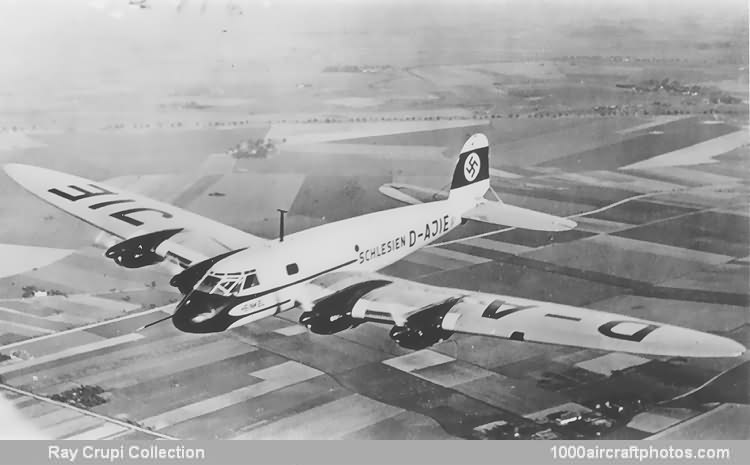Powered by four Hirth HM 508B engines driving two-bladed VDM (Vereinigte Deutsche Metallwerke, United German Metal Works) variable-pitch airscrews, the first prototype was flown by DLH pilot Robert Untucht on December 9, 1936. Due to a fault in the fuel supply, the aircraft was ditched on the Baltic Sea, however, due to the watertight riveted fuselage the aircraft stayed afloat and was towed to the Heinkel works at Marienehe near Rostock.
The heavily damaged wings were replaced by the wings assembled for the still under construction second prototype, and the He 116 V1 flew again in March 1937, making its acceptance flight on May 26, again with DLH pilot Untucht at the controls. Subsequently the aircraft received a DLH livery and was registered D-AJIE and named Schlesien (Silesia). Despite its livery it was still owned by the RLM, however, it was assigned to DLH for long-distance testing.
In January 1938, DLH renamed the aircraft Lübeck and used it for trials on the access route to the South Atlantic postal service. The D-AJIE was damaged on the return flight when landing in Las Palmas, Tenerife, Spain and had for repair to be returned to Germany with the MS Schwabenland (Swabia). Since the RLM found the repairs to costly and sold the aircraft for a bargain price to DLH, who had it repaired and fitted with an enlarged tail but about 66 lb (30 kg) lighter in weight. Between October 1938 and January 1939 flew on the post shuttle route Frankfurt - Las Palmas - Berlin, until it was transferred to the RLM in early 1939.
The second prototype, He 116 V2 (c/n 546), first flew on August 7, 1937 with Heinkel chief pilot Gerhard Nitschke at the controls and was operated by Lufthansa as D-ATIO, named Hamburg. Late March 1938, it flew trails on the route Berlin - Lisbon - Las Palmas, only two months later, May 27, it was destroyed upon water contact (due to pilot error) near the isle of Langeoog in the North Sea, killing the crew: captain Falke, flight engineer Kirchhoff und radio operator Kolbe. Shortly before the crash the aircraft had been fitted with HM 508J engines.
The RLM assigned the third prototype, He 116 V3 (c/n 1969), to Heinkel and was modified for distance record-breaking purposes. The wing span and area were increased to 82 ft (25.00 m) and 813.75 sq.ft (75.60 sq.m) respectively, fuel tankage was substantially augmented, and HM 508H engines were installed. Designated He 116 R, registered D-AFRD and named Rostock, the aircraft was equipped with four take off assistance rockets, but late June 1938, during the take off for the initial attempt on the distance record one of the rockets tore loose and severely damaged the wing.
After repairs, the He 116 R took off successfully on July 30, 1938, covering the closed circuit 6,214 mls (10,000 km) in 46 hr 18 min at an average speed of 134 mph (216 kmh). Crew members were captain Rudolf Jöster, engineer Hans Lausmann and radio operator Arthur Suppa. Late 1939 the aircraft was transferred to the Luftwaffe and was allotted the code "CB+QL". In 1943 it was stored for preservation with the German aviation collection at Berlin, but later it was destroyed in a bomb raid.
Japan expressed an early interest in the He 116 as the aircraft has an excellent range performance which offered good opportunities in the Pacific, and two aircraft were purchased for the Manchurian airline Manshu Koku Kabushiki Kaisha (Manchurian Air Transport). With the first of the two aircraft, registered J-BAKD and named Nogi, a Japanese crew participated in the so-called "Third Italian Sahara Flight", which took place February 17 to 28, 1938 in the former Italian colony of Libya. They took the lead in the competition, but had to resign on the third leg in the Jalu oasis due to a propeller failure damaging the engine. After repairs it returned to Germany.
The second Japanese aircraft, J-EAKF named Togo (reportedly c/n 1531), was accepted by a Japanese commission in Marienehe on March 16, 1938. Both aircraft, fitted with Hirth HM 508H engines, were transferred by Japanese crews from Berlin to Tokyo April 23 to 29, 1938, with six stops: Rhodes (Greece), Basrah (Iraq), Karachi (Pakistan), Calcutta (India), Bangkok (Thailand) and Taiwan. The aircraft landed on the Emperor's birthday, after ca. 9,000 mls (14,500 km) and ca. 56 flying hours. Both aircraft were operated till they were destroyed toward the end of WW II.
A military version was developed as the He 116 A-0."
The following data relate to the civil He 116.
Type: Four-engined long-range mail and freight-carrier.
Wings: Low-wing cantilever monoplane. Outer portions of wings are elliptical in plan and taper in thickness. Two-spar wooden structure. Trailing edge flaps.
Fuselage: Duralumin monocoque structure, with watertight bulkheads.
Tail unit: Cantilever monoplane type.
Landing gear: Retractable type. Landing wheels retract into tails of inner engine nacelles.
Power plant: Four 240 hp Hirth HM.508C eight-cylinder air-cooled inverted V-engines on steel-tube mountings in front of the leading edge of the wing. Total fuel capacity 687 gal (2,600 l) in four wing tanks.
Accommodation: Accommodation for two pilots, navigator, and wireless operator. Pilots seated side-by-side in nose, with dual controls. Navigation and radio compartments behind pilot's compartment. Mail and freight compartment over wing.
